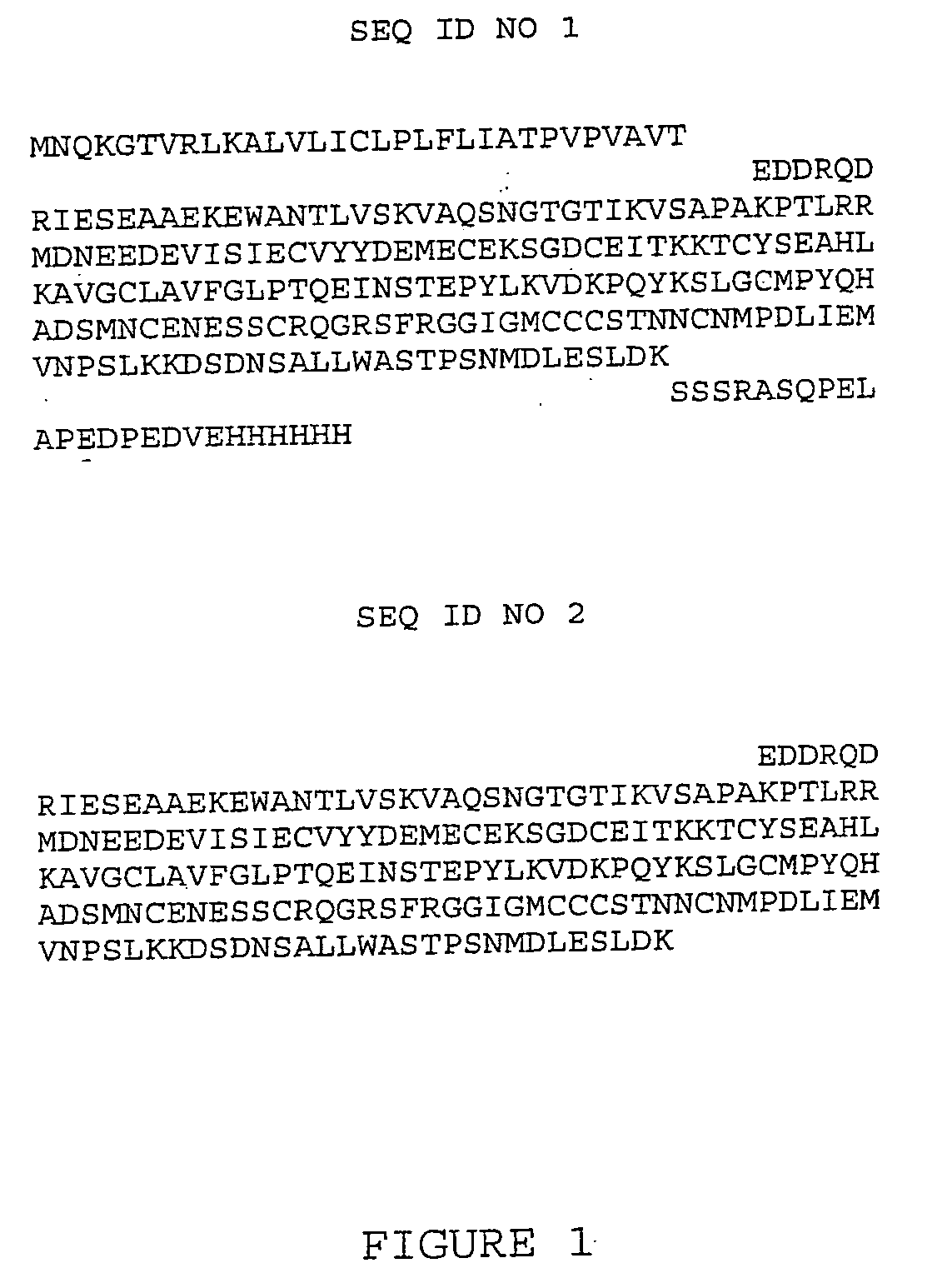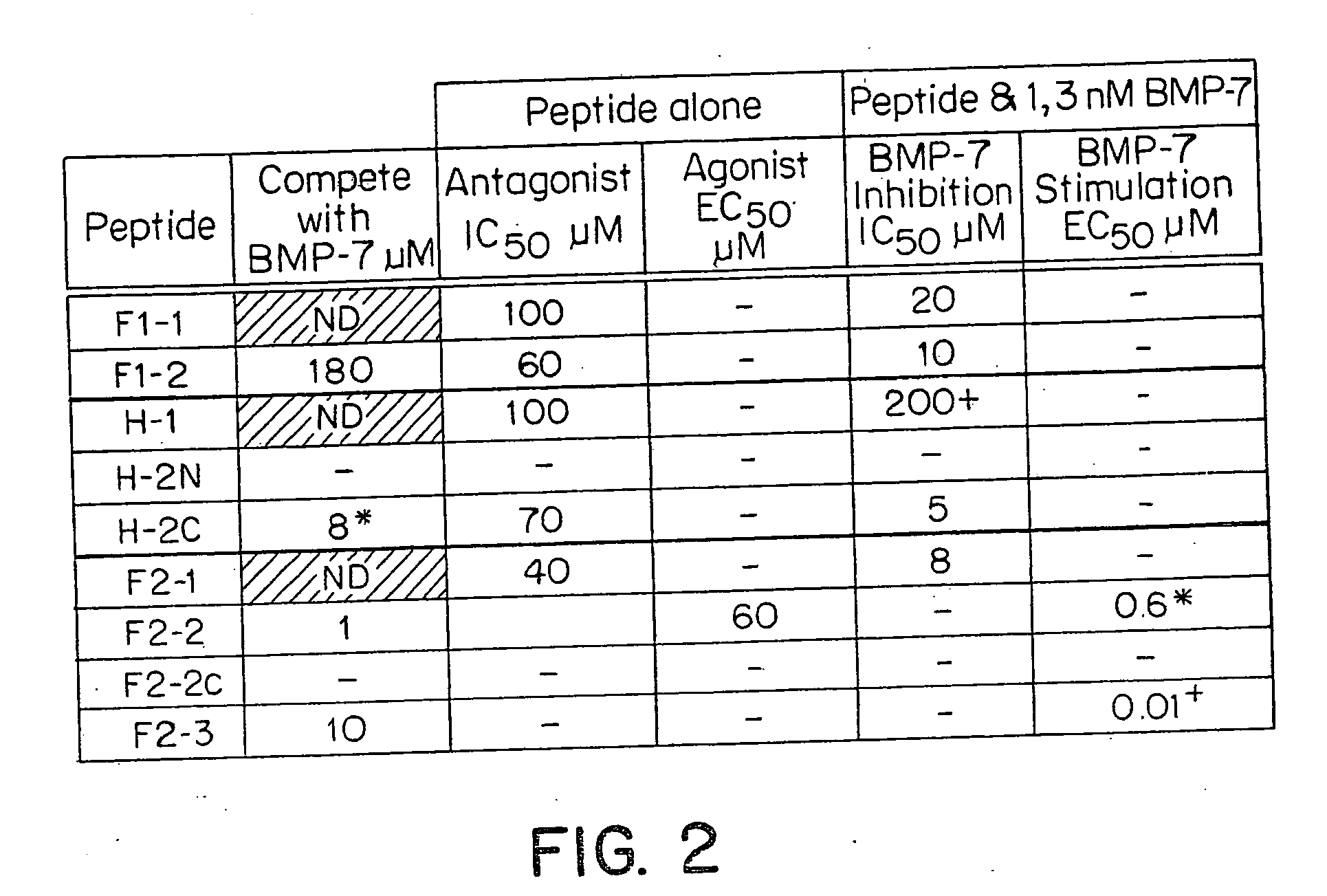Screening method for bone morphogenetic mimetics
a bone morphogenetic and mimetics technology, applied in the field of bone morphogenetic mimetics screening method, can solve the problems of undesirable side effects of initial bmp protein load, beset with a number of problems, etc., and achieve the effects of simple, rapid, convenient, and high throughpu
- Summary
- Abstract
- Description
- Claims
- Application Information
AI Technical Summary
Benefits of technology
Problems solved by technology
Method used
Image
Examples
example 1
[0047]Radio-ligand receptor Assay: The receptor-binding activities of various BMP ligands (New York Public Health Labs, Albany, N.Y.) were determined by an equilibrium displacement binding isotherm assay using BMP-7 receptor-enriched plasma membrane fraction of ROS cells (ATCC 17-2.8) and 125I-labeled BMP-7 (NEN, Billerica, Mass.) as ligand. Purified BMP-7 was radio-iodinated BMP-7 to a specific activity of 70-78 uCi / ug by a modified procedure of lactoperoxidase method (Schneyer, A. L., et al., Endocrinology 119, 1446-1453 (1986)). The percent bindability of radioiodinated BMP-7 to excess receptor is 30-37%. Receptors from ROS cells are obtained by a procedure previously described (Dattatreyamurty, B., et al., (1986) J. Biol. Chem. 261.). These preparations contain a single class of BMP-7 binding sites with an affinity (Ka) of 4.38×109 M−1 and an average BMP-7 binding capacity of 3.6 pmol / mg protein. In a typical assay, fixed amounts of 125I-labeled sol. BMP-7 (−80.000 cpm) were inc...
example 2
[0048]Type II Receptor-based ligand-blot technique: A novel ligand blot method was developed to characterize BMP-7 and test agent binding to ROS cell receptor. Test agents were analyzed by this method to determine their ability to interact with type II receptor. Based on their ability to inhibit 125I-labeled BMP-7 binding to the receptor. In a typical experiment, receptor-enriched ROS cell plasma membrane fraction was treated with SDS (final concentration 1.6% w / v) in the presence of 17% glycerol on ice, as described previously (Dattatreyamurty, B. & Reichert Jr., L. E. (1992) Endocrinology 131, 2437-2445.) and subjected to SDS-PAGE under non-reducing conditions and without prior heating of the samples, according to the procedure of Laemmli (Laemmli, UK (1970) Nature 227, 680-685). Receptor samples were electrophoressed at 35 mA and 4° C. in gradient (5-8% or 5-10% w / v) acrylamide separating gels. Pre-stained markers of known molecular weights were used as standards. After SDS-PAGE,...
example 3
In Vitro Bioassays
[0049]ROS Cell Based Alkaline Phosphatase Assays: BMP-7 and test agents that bind BMP-7 receptors were analyzed by in vitro bioassay. This assay defines the role of these test agents at the receptor-binding site. It is believed that some of the test agents can effectively interact with receptors and inhibit BMP-7 induced target cell responsiveness, thereby acting as functional antagonists. Alternatively, these agents may mimic BMP-7 functions inducing alkaline phosphatase activity in ROS cells, thus acting as functional agonists. An assay procedure as described by Maliakal, J. C., et al., Growth Factors 11, 227-234, (1994) determined the biological activities of BMP-7 peptides. In a typical experiment, rat Osteosarcoma (17 / 2.8) cells were plated in 96 well plates (3.0×104 cells / well) and incubated overnight at 37 C in 5-6% CO2 incubator. Next day, the plates were examined to make sure that cells are healthy & confluent. Cells were treated with increasing concentrat...
PUM
| Property | Measurement | Unit |
|---|---|---|
| Protein activity | aaaaa | aaaaa |
| Pharmaceutically acceptable | aaaaa | aaaaa |
Abstract
Description
Claims
Application Information
 Login to View More
Login to View More - R&D
- Intellectual Property
- Life Sciences
- Materials
- Tech Scout
- Unparalleled Data Quality
- Higher Quality Content
- 60% Fewer Hallucinations
Browse by: Latest US Patents, China's latest patents, Technical Efficacy Thesaurus, Application Domain, Technology Topic, Popular Technical Reports.
© 2025 PatSnap. All rights reserved.Legal|Privacy policy|Modern Slavery Act Transparency Statement|Sitemap|About US| Contact US: help@patsnap.com



